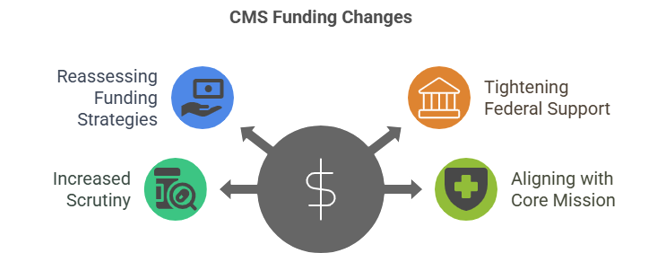
On April 10, 2025, the Centers for Medicare & Medicaid Services (CMS) issued a sweeping update that could significantly impact how states and providers leverage federal Medicaid dollars. CMS announced it will no longer approve or extend funding for Designated State Health Programs (DSHPs) and Designated State Investment Programs (DSIPs), two financing mechanisms that have helped states fund nontraditional healthcare initiatives for years.
What Are DSHPs and DSIPs?
DSHPs and DSIPs are state-run initiatives that historically allowed states to secure federal Medicaid matching funds for programs not typically eligible under standard Medicaid rules.
- DSHP (Designated State Health Program): Covers state-funded health-related programs that don’t fall under traditional Medicaid reimbursement categories like public health outreach or behavioral support.
- DSIP (Designated State Investment Program): Expands even further to fund non-clinical services or infrastructure that support health outcomes, such as high-speed internet for rural providers or nonmedical in-home care.
While both programs were created with good intentions, CMS and oversight bodies have expressed growing concern over their use as “creative financing mechanisms” that often stretch the boundaries of Medicaid’s core mission.
Why This Matters Now
CMS is taking action following years of concern from agencies like the Government Accountability Office. From 2019 to 2025, spending on DSHPs and DSIPs has ballooned from $886 million to nearly $2.7 billion—prompting worries about duplication of services and a lack of direct benefit to Medicaid-eligible individuals.
In its April 10 news release, CMS cited examples of spending that fall outside Medicaid’s core scope:
- $20 million in broadband grants for rural healthcare providers in North Carolina
- $241 million in nonmedical in-home support programs in New York
CMS says these initiatives “distract from the core mission of Medicaid” and sometimes “serve as an overly creative financing mechanism to skirt state budget responsibilities.”
The Bigger Picture: Budget Pressures
The same day CMS issued this notice, House Republicans passed the Senate’s FY 2025 budget blueprint, directing the House Energy and Commerce Committee to identify $880 billion in federal healthcare cuts—a target widely expected to affect Medicaid programs disproportionately.
Implications for Hospitals and States
- States must reassess funding strategies that rely on DSHP/DSIP flexibility.
- Hospitals that benefited from indirect support (like telehealth expansion, broadband access, or in-home services) may see a tightening of federal support.
- Providers should prepare for greater scrutiny and ensure all programs align with Medicaid’s core goal: delivering direct care to eligible beneficiaries.
Bottom Line:
This CMS decision marks a return to fundamentals—tightening Medicaid’s focus on its original mission and cutting back on state-level financial maneuvers. As federal oversight increases and budget pressure intensifies, hospitals and health systems must proactively align their programs with CMS expectations to safeguard future funding.


Leave A Comment
You must be logged in to post a comment.